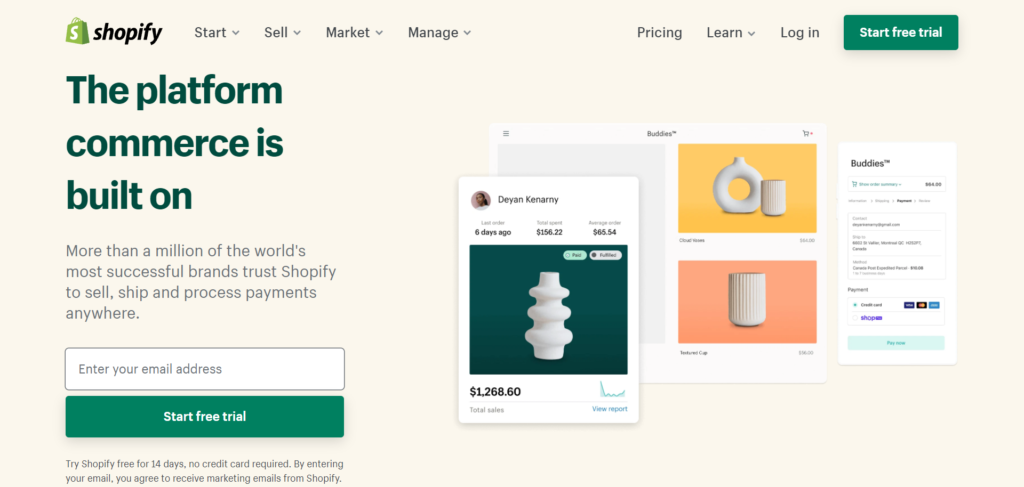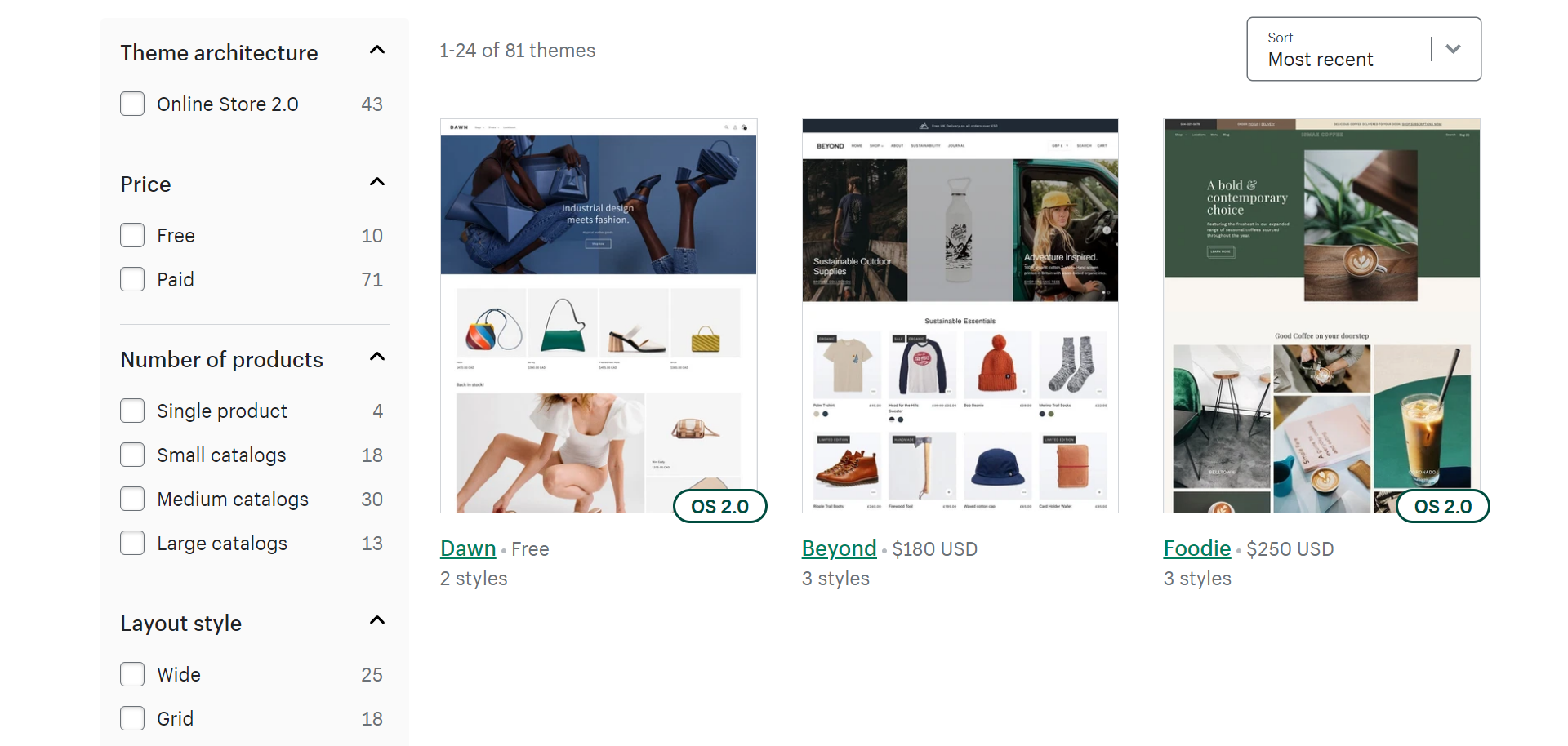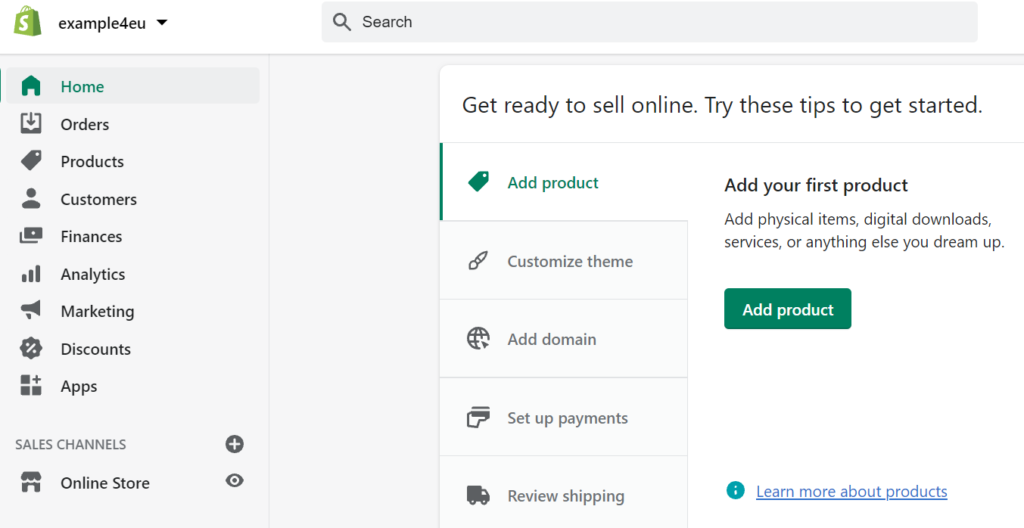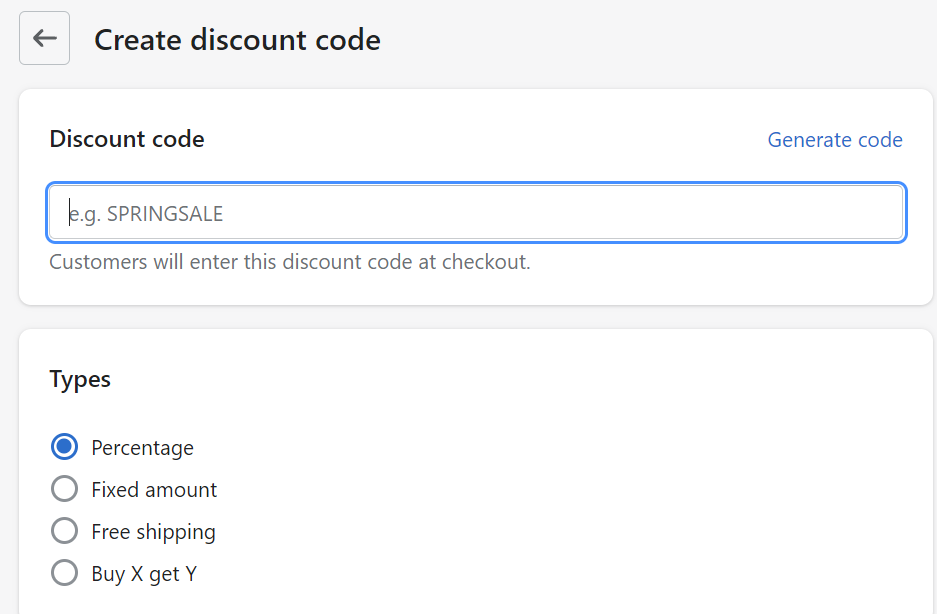If you're looking to launch an online store, then you're probably in the process of researching different eCommerce solutions. There are tons of options out there, two of them being Shopify and Joomla. Although each solution enables you to build an online store, they're very different frameworks. That said, let's dig into this Shopify vs Joomla review.
Hopefully, by the end, we'll have helped you get to the bottom of which, if either, is the right fit for you…
What is Shopify?

In short, Shopify is a SaaS that enables users to design and launch an online store using their fully-featured content management system. You can host your entire site on Shopify, so there's no need to research and purchase your own web hosting.
Shopify also comes with a POS, which permits you to sell in physical locations using Shopify's point-of-sale app. This software syncs inventory across your online and offline selling points, equipping you to view and manage stock from the convenience of your Shopify dashboard. As such, Shopify is an excellent choice for entrepreneurs running both online and brick-and-mortar businesses.
👉 Read our full Shopify review.
What is Joomla?

Put simply, Joomla is a free, open-source content management system you can use to create and publish web content.
You can compose a blog, business website, intranet, community website, etc. It doesn't matter the complexity of your web development project; Joomla's framework can handle it.
On top of that, Joomla also boasts a view–controller web application framework, which you can use separately from Joomla's CMS to build robust online apps.
Over the decades, Joomla has accrued several awards, including Best Free CMS from the CMS Critic People's Choice Awards in 2020, the Best Open Source Application in 2012 from Infoworld Bossie Awards, and the 2nd Runner-up Hall of Fame CMS in 2010 from Packt Open Source Awards.
Joomla vs Shopify: Website Templates

Having a professional-looking template to work from makes the process much easier when it comes to web design. With that in mind, let's see what Joomla and Shopify have to offer in this arena:
Joomla
Technically, Joomla doesn't offer a dedicated website template directory. However, plenty of third-party developers have created Joomla themes you can download and use – some are free, while others are paid-for.
As there's no official vetting process for these templates, you'll need to do your own research to determine quality, customizability, the cleanness of its code, etc.
Shopify

In contrast, Shopify offers users its own dedicated theme store, with tons of options to choose from. There are ten free themes and 71 paid-for options. All of which are mobile-friendly, boast clean code and are easily customizable using Shopify's website editor. You'll enjoy even more customization freedom if you boast some knowledge of the programming language “Liquid.”
Shopify vs Joomla: User-Friendliness and Ease of Use
In this part of the review, we'll take a quick look at how easy Joomla and Shopify are to use:
Joomla
Joomla's backend is pretty clean, making creating and publishing web pages and blog posts relatively intuitive. Just select a section, write your content, and hit publish.
However, to benefit from more advanced features, you'll need the know-how to code your desired designs/functionality. Alternatively, you'll need to be prepared to research, download, and use multiple Joomla extensions. However, sometimes these plugins are reportedly outdated and buggy. This makes it all the more important to research potential add-ons before downloading them.
Shopify

In contrast, Shopify's much easier to get started with. You don't need any technical know-how to make the most out of Shopify's out-of-the-box features. Instead, you just need to create a Shopify account and select your preferred pricing plan; after that, you're free to hit the ground running. From there, Shopify's admin area is incredibly user-friendly.
If you're new to eCommerce, there's a good chance you won't need any plugins, to begin with. However, as you start to grow and scale your business, there are tons of add-ons available on Shopify's app market.
Shopify's Core Features
As we've just alluded to, Shopify's suite of in-built features is incredibly extensive, so we won't have time to cover them all here.
But, as there's a good chance you're reading this comparison to help you decide which eCommerce platform is best for you; we'll focus on Shopify's storefront, marketing, and SEO functionalities:
For starters, there are over 70 professional and customizable themes to choose from, created by globally acclaimed designers, including Happy Cog, Clearleft, and Pixel Union. Combined with Shopify's easy-to-use website editor, it's easy to tinker with your theme's settings and aesthetics to bring your vision to life. On top of that, if you have some coding smarts, you can access your store's HTML and CSS to fine-tune every aspect of your website.
Shopify also furnishes users with a robust blogging engine. From here, you can write, publish, and categorize your articles. You can also permit readers to comment on blog posts, encourage discussion, and, of course, moderate these comments. You can also use Shopify's blogging platform to create lookbooks – which comes in especially handy if you're running a fashion brand.
You'll also be pleased to hear that Shopify comes with a mobile commerce shopping cart, which allows website visitors to peruse your store on desktop and mobile devices alike.
When it comes to SEO, Shopify supports plenty of search engine optimization best practices. For instance, you can edit meta titles, and tags and customers can leave product reviews. Not to mention, Shopify also generates a sitemap.xml of your products, web pages, and blog posts – making it much easier for search engines to scan and rank your website accordingly.
While we're on the subject of extending your reach, Shopify also gifts you $100 worth of Google ad credits when you spend $25 with Google.
Also, all Shopify websites integrate with various social media platforms, including Pinterest, Instagram, Facebook, Twitter, and Tumblr. More specifically, on Facebook, shoppers can browse and purchase products without ever leaving Facebook.
Lastly, if you're looking to increase sales, Shopify makes it easy to generate discount codes and sell gift cards to entice trade.

Joomla's Core Features
Now that we've covered Shopify's most notable features, let's take a look at Joomla's:
There are thousands of high-quality templates available created by third-party developers, many of which are free and come with a graphical user interface (GUI). This empowers you to change their colors, fonts, layouts, and features without writing a single line of code.
You also get access to a WYSIWYG (What You See Is What You Get) editor. This style of website builder makes it much easier to write and edit text, images, and formatting. In addition, there are several pre-installed modules available that enable you to showcase popular articles, new posts, newsflashes, related articles, etc. This makes Joomla an excellent choice for bloggers!
Speaking of, bloggers can organize their content into categories and tags,
create an RSS feed from their content, and display an external news feed on your website. You can also provide visitors with a search bar to help them navigate your website.
You also get access to out-of-the-box SEO and SEF features. For instance, you can edit metadata and optimize pages for keywords. It also provides the infrastructure you need to create clear and consistent sitemaps. Reportedly, Joomla also makes it pretty easy to redirect URLs when needed and can speed up your website's load times with caching.
Another one of Joomla's key features is that it's multilingual – in fact, it supports as many as 70 languages.
If you're looking to monetize your Joomla site, you can add banners and other website advertisements.
If you have a small team, you can register multiple users and manage their permissions. From there, you can also send messages between admins.
Lastly, if you want to extend Joomla's functionality (and can't/don't want to code), there are over 8,000 extensions over on Joomla's Extensions Directory – extensions.joomla.org. So, you're bound to find an add-on to suit your needs!
Shopify and Joomla's Pros and Cons
Now that we've covered the basics, let's take a look at Shopify and Joomla's pros and cons:
Shopify's Pros:
- Shopify's platform is straightforward to use.
- Shopify's themes are beautiful and mobile-friendly
- You can send abandoned cart campaigns on all plans, which is rare amongst platforms charging similar price points.
- Shopify can automatically calculate US, Canadian, EU, and UK tax.
- Shopify comes with free, in-built email marketing functionality that enables you to store up to 2,500 subscribers.
- Shopify's point-of-sale offer is pretty comprehensive.
- You can easily extend Shopify's functionality thanks to its vast range of plugins available
- If you use Shopify Payments, you won't be charged extra transaction fees.
- Shopify supports lots of third-party payment gateways, including popular names like PayPal.
- You can try Shopify for free for 14 days.
Shopify's Cons:
- While you can create 100 product variations, these only span three product options – i.e., size, color, style, etc.
- You only get access to professional reporting functionality with Shopify's more expensive plans.
- Shopify no longer supports a native Mailchimp integration.
- Although Shopify's in-built email marketing functionality is handy, it's still pretty basic.
Joomla's Pros:
- Joomla is an open-source platform, so you can modify and distribute your website's code with ease if you have the coding smarts.
- Joomla's free to download and use
- Creating blog content is easy – writing a blog post feels more like creating a document in a traditional word processing program than a coding software.
- There's plenty of self-help support available. Joomla's online community forums are pretty active and, as such, have populated tons of support tutorials and materials.
- You can collaborate with team members by granting them user access.
- Joomla is a multilingual platform.
Joomla's Cons:
- Joomla comes with a steeper learning curve than Shopify. Open-source frameworks are a bit of a double-edged sword that way, as getting up and running and creating your own designs requires a little more technical know-how.
- Some users report compatibility issues with some of Joomla's plugins.
- Some of Joomla's best templates come with a price tag.
- Joomla doesn't have a dedicated customer support team you can contact
Shopify's Pricing
Finally, let's take a quick look at how much Shopify costs:
Basic Shopify
For $29 a month, this is best for those looking to launch a new eCommerce website and make the occasional in-person sale.
Shopify
For $79 a month, the Shopify plan is best suited to businesses looking to grow their online and/or in-person operations.
Advanced Shopify
Here the price jumps substantially up to $299 a month. As a result, this package is best suited to larger enterprises looking to scale their business with advanced reporting functionalities.
Joomla's Pricing
Joomla is completely free to download and use. However, you'll need to purchase your own web hosting and domain name.
Joomla vs Shopify: Our Final Verdict
So, there you have it, our Joomla vs Shopify comparison. In short, if you don't have any coding or technical smarts, Shopify's easier to use, set up, and launch your eCommerce business. But best of all, it suits beginners and small businesses and those looking to grow and scale their operations.
However, suppose you're a web developer looking for an open-source framework. In that case, Joomla will provide you with the sort of developer-friendly framework you're looking for.
So, which (if either) of these platforms do you think best suits your needs? Or, are you considering other alternatives like WordPress and WooCommerce, Virtuemart, Wix, BigCommerce, Drupal, or Magento? Either way, tell us all about it in the comments box below!




Comments 0 Responses